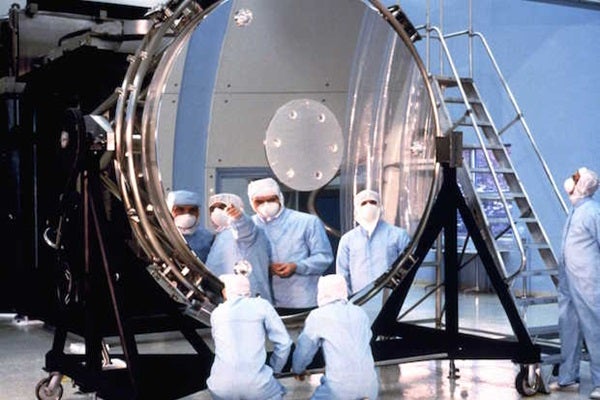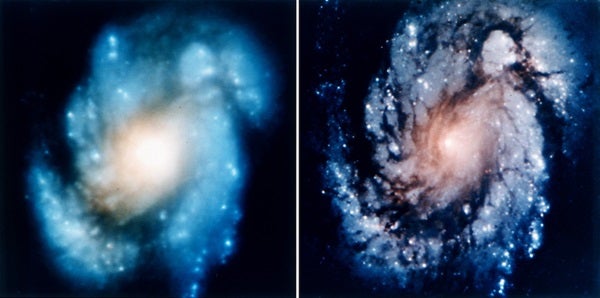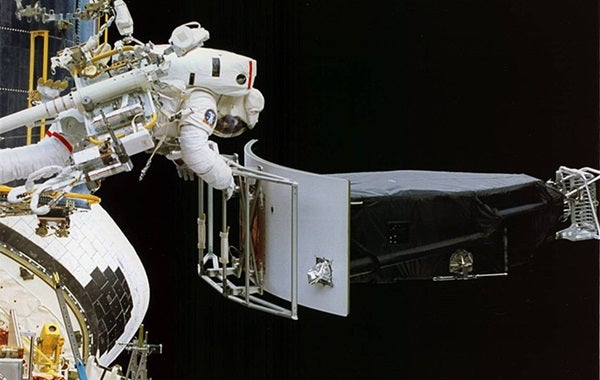When the Hubble Space Telescope rose from Earth in April 1990, it was lauded as the eighth wonder of the world. As the most capable observatory ever built, it had grand plans to be a new window to the cosmos. It would unveil the universe with a clarity never before possible, peering deeper into space — and, therefore, further back in time — than any instrument before it.
But just eight weeks after launch, Hubble’s fortunes suffered an abrupt about-face, quickly mutating it from a white knight of science to a white elephant of shame.
Hubble, Hubble, you’re in trouble
At first, the school-bus-sized telescope largely lived up to expectations. Despite communications problems, drifting star trackers, and snagging coaxial cables, mission controllers weren’t initially struck by dread. After all, these issues were teething troubles that plagued all new spacecraft. Just a month in, Hubble even captured an 8.2-magnitude star in the constellation Carina. And when compared to ground-based images, the space telescope’s superiority was self-evident.
However, that shot proved to be a false dawn. On June 24, 1990, Hubble full-out failed a focusing test. Its secondary mirror, meant to focus incoming light, didn’t seem to be behaving as it should. Even Hubble’s best shots were strangely blurred and surrounded by fuzzy rings. Tests diagnosed the problem as ‘spherical aberration.”
From there, it quickly became horrifyingly clear that the problem wasn’t related to a software glitch or mechanical issue; optics contractor Perkin-Elmer had ground Hubble’s primary mirror to the wrong specification. The company had removed too much glass, resulting in a primary mirror that was too flat by about 1/50 the width of a human hair.
In other words, Hubble was good, but not great.
The “techno-turkey” gets dragged under the bus
Following the announcement that a $1.5 billion (at the time) project wasn’t even manufactured to specifications, the public and political reaction was immediate — and laced with recrimination. Everyone, whether invested in Hubble or not, seemed to pile on the space telescope’s very public failure.
Senator Barbara Mikulski famously branded the telescope a “techno-turkey,” while others lambasted NASA’s quality-control procedures. David Letterman compiled a pejorative list of “Top Ten Hubble excuses.” And in July, the New York Times reported that, at $64.2 million, Perkin-Elmer turned out to be the lowest bidder to build Hubble’s all-important mirror. Competitor Kodak-Itek, whose rejected bid came in at $99.8 million, would have even included independent checks of the mirror, which likely would have caught the aberration before Hubble ever launched.
As the revelations spilled out, NASA grew increasingly embarrassed. Its Space Shuttle program — which had just recently returned to service after the Challenger disaster — was grounded again that same summer due to fuel leaks. Plus, the hopes of securing congressional funding for the International Space Station teetered on the knife-edge of cancellation.
Space policy analyst John Logsdon thinks the problem was that NASA attitudes towards planning and anticipating challenges had shifted markedly since the 1960s. He says the space agency “was not being honest with itself or anyone else.”

Are you ready to take a closer look at NASA’s best space probes? Check out our free downloadable eBook: NASA’s Greatest Space Probes.
The root cause of Hubble’s poor eyesight
An investigation spearheaded by Lew Allen, then director of the Jet Propulsion Laboratory in California, led to the publication of “The Hubble Space Telescope Optical Systems Failure Report” in November 1990. In it, he managed to trace the original cause of Hubble’s devastating aberration all the way back to 1981.
The report suggested principal blame for the costly error fell on a device called the reflective null corrector, which was designed to ascertain the final figure of Hubble’s mirror. Unfortunately, one of device’s lenses was flawed, which guided the mirror polisher to shape the wrong curvature. However, people were largely at blame too; Allen’s report also identified multiple failings in the form of poor communication and lack oversight, both by NASA and Perkin-Elmer.
Because Hubble’s two spectrometers didn’t require very focused light to function, they were less affected by the flawed mirror. But Hubble’s high-speed photometer was virtually useless, and its Wide Field/Planetary Camera and Faint Object Camera both suffered impaired spatial resolution.
Hubble gets glasses
While it is true that Hubble’s mirror had been botched, a saving grace was that it had been screwed up with extreme precision. By calculating the differential between the actual and the desired mirror curvatures, a set of corrective optics could be designed. Basically, Hubble could get glasses.
In October 1991, NASA contracted Ball Aerospace to build the Corrective Optics Space Telescope Axial Replacement (COSTAR), whose ten tiny mirrors would restore Hubble’s vision once and for all.
Yet that doesn’t mean Hubble remained useless until COSTAR was installed. The aberration was stable and well-characterized, allowing engineers to devise software algorithms and image-processing methods that could remove the blurring effects. During the three years before COSTAR was manufactured and fitted onto the space telescope, 25 percent of all research papers submitted to the American Astronomical Society drew directly from Hubble data.
Even in its compromised state, the telescope managed to discover a huge equatorial storm on Saturn, observe Jupiter’s aurorae, and track the evolving weather patterns on Mars. It found some of the most massive stars known, peered deep into the cores of galaxies in search of black holes, and revealed a colossal gaseous ring around Supernova 1987A. even as jokes about Hubble’s faults continued to flood in, the space telescope remained as focused as it could on exploring the chemistry of the early universe, studying the most distant known galaxies, and measuring the size and age of the cosmos.
COSTAR was eventually installed on Hubble by astronauts during a spacewalk in December 1993. Immediately, the device triumphantly restored the telescope’s vision. This laid the groundwork for a quarter-century of astounding Hubble discoveries, many of which rewrote astronomy textbooks and redefined our place in the grand scheme of the cosmos.
So, for a telescope that was once labeled a “techno-turkey” and served as the butt of relentless ridicule on late-night TV, it’s fair to say that Hubble has had one heck of a redemption arc.












